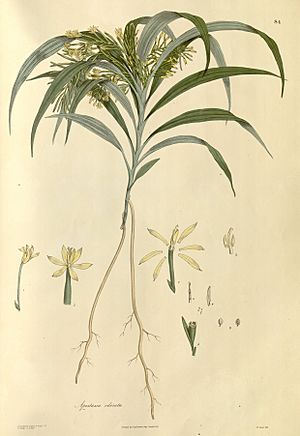Grass orchids facts for kids
Quick facts for kids Grass orchids |
|
|---|---|
 |
|
| Apostasia wallichii | |
| Scientific classification |
|
| Kingdom: | Plantae |
| Clade: | Tracheophytes |
| Clade: | Angiosperms |
| Clade: | Monocots |
| Order: | Asparagales |
| Family: | Orchidaceae |
| Subfamily: | Apostasioideae |
| Genus: | Apostasia Blume |
| Species | |
|
See text |
|
| Synonyms | |
Apostasia, often called grass orchids, is a group of eight types of very old-fashioned orchids. They belong to the Orchidaceae family. These plants grow on land and stay green all year, looking a lot like grass. You might not even guess they are orchids! They grow in wet places like the Himalayan region, China, India, Sri Lanka, Southeast Asia, New Guinea, and Queensland. Grass orchids have many thin leaves and small, star-shaped flowers that are usually yellow or white. These flowers grow on a stem that often has branches.
Contents
What are Grass Orchids Like?
Apostasia plants are evergreen (they stay green all year). They grow on land and look like grass. They have a scaly rhizome (an underground stem) with a few roots. Sometimes, these roots can grow into tubers, which are like small storage lumps.
Their stems are thin and covered with many long, narrow leaves that look like grass. These leaves grow in a spiral pattern around the stem. The flowers are small and can be yellow or white. They grow on a short stem that often has branches.
Unlike many orchids you might know, the three sepals (leaf-like parts protecting the bud) and three petals (the colorful parts of the flower) of Apostasia flowers are all similar in size, shape, and color. Most other orchids have one special petal called a labellum that looks different.
Also, the parts inside the flower, called the column, are different. The two stamens (which make pollen) are separate from the style (the part that receives pollen). The pollen grains do not stick together in special bundles called pollinia, which is common in other orchids.
How Grass Orchids Got Their Name
The group of plants called Apostasia was first officially described in 1825. This was done by a scientist named Carl Ludwig Blume. He wrote about them in a book called Bijdragen tot de flora van Nederlandsch Indië.
The name Apostasia comes from an Ancient Greek word, apostasis. This word means "defection" or "departure from." It was chosen because these orchids have features that are quite different from most other orchids. They seem to "depart" from the usual orchid look.
There are two main groups of orchids in a special subfamily called Apostasioideae: Apostasia and Neuwiedia. These two groups are different from most other orchids because they have three stamens. Most orchids only have one stamen. Scientists believe these two groups are like "sister" groups. This means they are closely related to each other, but they are not the direct ancestors of all other orchid families. They just show some very old, "primitive" features.
Where Do Grass Orchids Grow?
Apostasia species are found in many places across Asia and Australia. You can find them from north-eastern India, Nepal, and Bhutan, all the way to southern Japan. They also grow throughout Southeast Asia, reaching New Guinea and northern Australia.
For example, three different species of Apostasia grow in China. One of these species is endemic to China, meaning it is found nowhere else in the world. Another species is endemic to Queensland, Australia.
List of species
Here is a list of the Apostasia species recognized by the World Checklist of Selected Plant Families as of August 2018:
- Apostasia fogangica Y.Y.Yin, P.S.Zhong & Z.J.Liu 2016
- Apostasia latifolia Rolfe, 1889.
- Apostasia nuda R.Br., 1830.
- Apostasia odorata Blume, 1825.
- Apostasia parvula Schltr., 1906.
- Apostasia ramifera S.C.Chen & K.Y.Lang, 1986.
- Apostasia shenzhenica Z.J.Liu & L.J.Chen, 2011.
- Apostasia wallichii R.Br., 1830.
See also
 In Spanish: Apostasia (orquídea) para niños
In Spanish: Apostasia (orquídea) para niños

